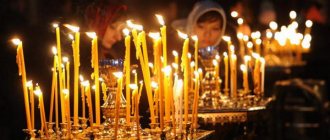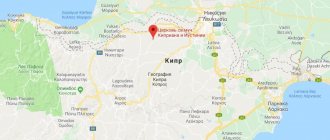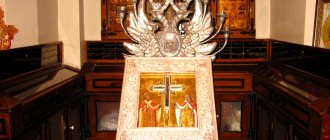Wikipedia has articles about other people named Euphrosyne.
| Euphrosyne of Suzdal | |
| Sewn veil. Rus. XVII (?) century | |
| Name in the world | Feodulia Mikhailovna Chernigovskaya |
| Birth | 1212(1212) Chernigov (?) |
| Death | September 25, 1250 (1250-09-25) Intercession Monastery (Suzdal) |
| Monastic name | Euphrosyne |
| Glorified | 18.09.1698 |
| In the face | Reverend |
| Main shrine | Intercession Monastery (Suzdal) |
| Day of Remembrance | glorification - September 18 (October 1); death September 25 (October 8); September 20 - in the Cathedral of Bryansk Saints, June 23 - in the Cathedral of Vladimir Saints |
| Attributes | monastic vestments |
Euphrosyne of Suzdal
(in the world Princess
Feodulia Mikhailovna of Chernigov
; 1212 - September 25, 1250) - Orthodox saint.
Biography
Her parents were the holy martyr Prince Mikhail Vsevolodovich of Chernigov, and her mother was the daughter of Roman Mstislavich Galitsky, whose name has not reached us. According to the life[1], Euphrosyne was the first begged child, before whose birth the couple prayed earnestly. Boyar Theodore, who was later martyred along with the prince in the Horde, influenced her education.
She mastered literacy at the age of 9. The Life reports that Alexander Nevsky's brother Fyodor Yaroslavich was chosen as a groom for the princess, but he died unexpectedly at the age of thirteen in Novgorod on June 5, 1233.
The princess remained in the Suzdal convent, where she soon took monastic vows with the name “Euphrosyne” (in honor of Saint Euphrosyne of Alexandria). Over time, she became his abbess.
On the initiative of the saint, the Trinity Monastery was founded in Suzdal for the tonsure of “married wives.”
The year of Eurofsinia’s death is not indicated in the Life; the date found in the literature - 1250 - is a guess.
The Life reports that the saint was buried on September 27 in the Deposition of Robe monastery, mourned by the clergy and all the people.
The fate of the relics in the 20th and 21st centuries[ | ]
On February 12, 1919, the saint’s relics were uncovered. The result of the opening of the relics in the report of the VIII Department of the People's Commissariat of Justice of the RSFSR to the Congress of Soviets was described as follows: “a cloth doll with pieces of bones”[3]. The relics were transferred to the Suzdal Museum, and in 1988 they were transferred to the only church then operating in Suzdal in the name of Equal-to-the-Apostles Constantine and Helen, which from 1993 to 2010 was under the jurisdiction of the schismatic Russian Orthodox Autonomous Church[2].
In 2009, the territorial department of the Federal Property Management Agency filed a lawsuit to seize 13 real estate objects from the ROAC, including the Tsar Constantine Church. The Arbitration Court of the Vladimir Region upheld this claim, but representatives of the ROAC clergy placed the relics of the saints in their Iveron Synodal Church and refused to return them to the state[4].
On February 16, 2012, the head of the territorial department of the Federal Property Management Agency for the Vladimir Region, Vladimir Gorlanov, sent a lawsuit to the Arbitration Court of the Vladimir Region, in which he argued that the relics of St. Euthymius of Suzdal and Euphrosyne of Suzdal “are the property of the Russian Federation and are classified as cultural objects”[5].
On May 31, 2012, the court decided to transfer the relics of St. Euthymius and Euphrosyne of Suzdal to the Federal Property Management Agency; fines were imposed for failure to comply with the decision and refusal to transfer the relics of the ROAC. On January 24, 2013, the Federal Arbitration Court of the Volga-Vyatka District overturned previous decisions on the confiscation of the relics, leaving them in the possession of the ROAC. However, on August 30, 2013, bailiffs entered the Iveron Synodal Church during a service and tried to seize the relics of Saints Euthymius and Euphrosyne[6].
The Federal Property Management Agency had to re-prove its rights to the relics in the courts of general jurisdiction, which also recognized them as belonging to the state[7][8].
On July 3, 2014, the Constitutional Court of the Russian Federation refused to satisfy the complaint of the Primate of the ROAC, Metropolitan Feodor (Gineevsky), against the decision to confiscate the relics of Euthymius and Euphrosyne of Suzdal from the church. The decision on the complaint was published on July 16[9].
On March 25, 2015, employees of the Federal Bailiff Service carried out compulsory enforcement actions to confiscate the relics of believers of the Russian Orthodox Autonomous Church from the Iversky Church in Suzdal. Parishioners and priests of the ROAC tried to prevent the removal of the shrine containing the relics, but after a small clash the bailiffs managed to remove them[10]. In mid-April 2015, the relics of Euphrosyne were placed in a special reliquary and placed in the Deposition of the Robe Cathedral in the Deposition of the Robe Monastery of the Russian Orthodox Church in Suzdal[11].
Veneration and canonization
The beginning of all-Russian veneration of Euphrosyne began after the consecration in 1517 of Archimandrite Gennady, who was close to Grand Duke Vasily III, as Bishop of Suzdal and Tarusa.
The Life was written by Gregory, a monk of the Suzdal Spaso-Evfimiev Monastery. It, in addition to the story of the miracles performed by the saint during his lifetime, contains two stories about posthumous miracles, which the author witnessed, one dated May 1, 1558. Apparently, the life was created at the turn of the 50s and 60s of the 16th century[2].
On September 18, 1698, with the blessing of Patriarch Adrian, Metropolitan Hilarion of Suzdal glorified the Venerable Euphrosyne. At the same time, the relics were found and placed in the monastery cathedral. After the revolution, they ended up in the Suzdal Museum, and in 1988 they were transferred to the only church then operating in Suzdal in the name of Equal-to-the-Apostles Constantine and Helen, which from 1993 to 2010 was under the jurisdiction of the schismatic Russian Orthodox Autonomous Church[2].
Prayers
Troparion, tone 4
Your holy memory rejoices the Suzdal country, / and calls all the faithful to your all-honorable temple, / where now your all-glorious memory is celebrated, Venerable Euphrosyne: / pray to Christ God / for our souls to be saved.
Kontakion, tone 2
A pure vessel of virginity filled with oil of prayer and love, / you kindled an unquenchable lamp in your heart, O venerable one, / with it you went forth cheerfully to meet the Heavenly Bridegroom, / you were received into His bright palace, / where you now join the faces of angels and saints, / pray, we pray, to Christ God, / to deliver us from some of the foolish virgins.
Kontakion, tone 6
My Sweetest Bridegroom, / The beautiful Euphrosyne cried out to Christ, / for the sweetness of Thy love fills my soul with hope / and the beauty of Thy mercy delights my heart, / to labor together in suffering for You, having hope in You, / that I may be worthy of the palace with the wise virgins / and rejoice at We will give you communion. / Moreover, reverend one, in reverence for the feat of your labors, we pray to you: / pray that the door of the palace will not be seen by us.
Kontakion, tone 8
You made virginity possible through purity, / and you enlightened your spiritual purity, / through fasting and vigil, you enslaved the flesh to the spirit, / and, Venerable Euphrosyne, / honoring the feats of your labors, we pray: / pray to Christ God for the salvation of our souls.
Excerpt characterizing Euphrosyne of Suzdal
Pierre sat opposite Dolokhov and Nikolai Rostov. He ate a lot and greedily and drank a lot, as always. But those who knew him briefly saw that some big change had taken place in him that day. He was silent the entire time of dinner and, squinting and wincing, looked around him or, stopping his eyes, with an air of complete absent-mindedness, rubbed the bridge of his nose with his finger. His face was sad and gloomy. He seemed to not see or hear anything happening around him, and was thinking about something alone, heavy and unresolved. This unresolved question that tormented him, there were hints from the princess in Moscow about Dolokhov’s closeness to his wife and this morning the anonymous letter he received, in which it was said with that vile playfulness that is characteristic of all anonymous letters that he sees poorly through his glasses, and that his wife’s connection with Dolokhov is a secret only to him. Pierre decidedly did not believe either the princess’s hints or the letter, but he was now afraid to look at Dolokhov, who was sitting in front of him. Every time his gaze accidentally met Dolokhov’s beautiful, insolent eyes, Pierre felt something terrible, ugly rising in his soul, and he quickly turned away. Unwittingly remembering everything that had happened with his wife and her relationship with Dolokhov, Pierre saw clearly that what was said in the letter could be true, could at least seem true if it did not concern his wife. Pierre involuntarily recalled how Dolokhov, to whom everything was returned after the campaign, returned to St. Petersburg and came to him. Taking advantage of his carousing friendship with Pierre, Dolokhov came directly to his house, and Pierre accommodated him and lent him money. Pierre recalled how Helen, smiling, expressed her displeasure that Dolokhov lived in their house, and how Dolokhov cynically praised the beauty of his wife, and how from that time until his arrival in Moscow he was not separated from them for a minute. “Yes, he is very handsome,” thought Pierre, I know him. It would be a special delight for him to dishonor my name and laugh at me, precisely because I worked for him and looked after him, helped him. I know, I understand what salt this should give to his deception in his eyes, if it were true. Yes, if it were true; but I don’t believe, I don’t have the right and I can’t believe.” He recalled the expression that Dolokhov's face took on when moments of cruelty came over him, like those in which he tied up a policeman with a bear and set him afloat, or when he challenged a man to a duel without any reason, or killed a coachman's horse with a pistol. . This expression was often on Dolokhov's face when he looked at him. “Yes, he’s a brute,” thought Pierre, it doesn’t mean anything to him to kill a man, it must seem to him that everyone is afraid of him, he must be pleased with this. He must think that I am afraid of him too. And I’m really afraid of him,” thought Pierre, and again with these thoughts he felt something terrible and ugly rising in his soul. Dolokhov, Denisov and Rostov were now sitting opposite Pierre and seemed very cheerful. Rostov chatted merrily with his two friends, one of whom was a dashing hussar, the other a famous raider and rake, and occasionally glanced mockingly at Pierre, who at this dinner impressed with his concentrated, absent-minded, massive figure. Rostov looked at Pierre unkindly, firstly, because Pierre, in his hussar eyes, was a rich civilian, the husband of a beauty, generally a woman; secondly, because Pierre, in the concentration and distraction of his mood, did not recognize Rostov and did not respond to his bow. When they began to drink the sovereign's health, Pierre, lost in thought, did not get up and take the glass. - What are you doing? - Rostov shouted to him, looking at him with enthusiastically embittered eyes. - Don't you hear? health of the sovereign emperor! - Pierre sighed, stood up obediently, drank his glass and, waiting until everyone sat down, turned to Rostov with his kind smile. “But I didn’t recognize you,” he said. - But Rostov had no time for that, he shouted hurray! “Why don’t you renew your acquaintance,” Dolokhov said to Rostov. “God be with him, you fool,” said Rostov. “We must cherish the husbands of pretty women,” Denisov said. Pierre did not hear what they said, but he knew that they were talking about him. He blushed and turned away.
Venerable Euphrosyne of Suzdal
Your holy memory rejoices the Suzdal country, and it convenes all the faithful to your all-honorable temple, where now your all-glorious memory is celebrated, Saint Euphrosyne; pray to Christ God for the salvation of our souls. Troparion, tone 4
How can one divide the history of Kievan Rus into Ukrainian and Russian? Although some of the current Ukrainian historians, following M. Grushevsky, equate Russia and Ukraine. That is, ancient Rus' is Ukraine, therefore the ancient Russian princes are Ukrainian princes. Like, for example, Oleg the Prophet. Under the peace treaty with Byzantium (907), he allegedly signed: “Oleg, Grand Duke of Ukraine”... At least they indicated the source where they got it from. His saying is widely known: “Let Kyiv be the mother of Russian cities.” And we will replace “Russian” with “Ukrainian”. And now the history of Ukraine is ready for you, you can teach children in school using it. They're digging deep! Well, if they dig, it means they find something, how could they do without it? So we got to the bottom of the origins of the “language”. It turns out that the Ukrainian language is the most... It even lies at the basis of Sanskrit and was brought to Earth from Venus. (A. Bratko-Kutynsky. “The Phenomenon of Ukraine.” “Evening Kyiv,” 06/27/1995.)
Someone looks at the past from their bell tower, remembering personal grievances concerning their ancestors or themselves. And he finds responses in it for his embittered soul. But it is known that when resentment clouds the eyes, a person does not listen to the arguments of reason. It’s even worse when, to please the political moment, they write to order and give out tons and kilometers of inveterate lies. And the younger generation is brought up on this “innocent” lie. Deliberately deforming the consciousness of young people, drumming into their heads a new “inadequate” history of Ukraine.
* * *
Prince Mikhail of Chernigov, in the 16th century.
canonized, and his wife Elena (sister of Daniil of Galicia) had a family that, by today's standards, is considered large. The Velvet Book (1687), which lists all the noble Russian families, mentions five sons of the prince: Rostislav, Roman, Semyon, Mstislav, Yuri. It is known that Mikhail Vsevolodovich also had a son, who tragically died as a minor in Germany, where the prince and his immediate circle fled to escape the Mongol-Tatars. He also had two daughters: Feofania and Maria, outstanding Russian women for their time, who left a noticeable mark in the memory of their contemporaries. The fate of the children of Mikhail Chernigov turned out differently. Rostislav, the eldest of the sons, married Anna of Hungary, and his family took deep roots in a foreign country. And daughter Maria married Vasilko Konstantinovich, Prince of Rostov, and after his death at the hands of the Mongol-Tatars, she founded a monastery in memory of her husband not far from Rostov, in which ours rests (1271). But the other sons of Mikhail Chernigovsky became the founders of well-known surnames in Rus': the Volkonskys, Dolgorukovs, Odoevskys, Repnins and many, many others. The entire twelfth chapter of the Velvet Book is dedicated to the glorious family tree of the prince. And his eldest daughter Euphrosyne of Suzdal, just like Mikhail of Chernigov himself, was canonized by the Russian Orthodox Church. These were such nice children that the prince and his lady Elena had!
According to legend, Mikhail Vsevolodich and Elena ardently desired heirs, so they diligently visited the Pechersk Monastery and prayed to God to give them children. They then lived in Kyiv at the court of the great Kyiv prince Vsevolod Chermny, father of Mikhail. Through fervent prayers, the Mother of God appeared to them and predicted the birth of a daughter, who in her youth would become the bride of Christ - she would go to the Suzdal monastery there to devote her short life to serving the Lord. And when Elena was safely delivered from her pregnancy, the happy parents named their daughter Theodulia (translated from Greek - servant of God). Such a memorable event in their lives happened in 1212.
In memory of this ever-memorable incident, the newborn was baptized in the same Pechersk monastery, the abbot himself dipped the child into the font. Already from infancy, the girl surprised her parents: she refused to take the nurse’s breast if she had eaten meat or dairy the day before. And when Theodulia grew up, she abandoned the humble diet and ate very sparingly: bread, salt and water became her daily food. The penance that the daughter voluntarily imposed on her so young shoulders caused reasonable concern among the parents, but according to common sense, they left her alone.
The prince's family was reputed to be devout, so it is not surprising that Theodulia diligently attended church. And boyar Fyodor, a friend of the prince in his youth, became her home teacher. It was under his watchful eye that the girl learned to read and write early and became known as a literate youth beyond her years.
Surrounded by a loving family and pious prayers, the youth of God's servant Theodulia passed. She read a lot, comprehending the wisdom of books, and her heart longed for the divine Revelation, given to people by the Almighty for the salvation of their souls. And one day a miracle happened, she was granted a vivid dream. The coming Day of Judgment appeared in her eyes with a colorful picture: fires were burning everywhere, angels were separating the righteous from the sinners - each was determined according to his faith, and the Lord with the Book of Life in his hand and the Mother of God standing at the right hand beckoned her to him. And somehow she dreamed of the Kiev-Pechersk Monastery with all its brethren. Humbly bowing down, they offered praise to the Almighty.
And at the same time, in the north-eastern Russian side, the abbess of the Suzdal Robe Monastery also had a vision that soon a young nun of noble origin would appear in the monastery, who would become famous throughout Rus' for her pious life and the accomplishment of godly deeds.
Behind the walls of the parental home, life was seething in a far from spiritual way, sometimes dictating its own harsh conditions to people, often incompatible with the norms of Christian morality. They disgusted the pious girl, but while she lived in this world, she had to follow them strictly. And then an event occurs in the life of young Theodulia, which is interpreted confusingly by descendants. You can find out that her 15-year-old (21-year-old?) was wooed to the Novgorod (Suzdal?) prince Theodore, the son of Yaroslav Vsevolodich. The groom was seven years younger than her. If this is really the case, then Mikhail Chernigovsky agreed to this marriage (this happened often in the past, and no wonder in the present), pursuing his personal, very ambitious goals. He and Yaroslav Vsevolodich at this time were already competing with might and main over Novgorod the Great. And Mikhail of Chernigov again, but briefly, became the prince of Novgorod (1229), then he was again replaced by Yaroslav Vsevolodich (1230-1233).
The marriage union of their children was supposed to reconcile the two most powerful families in Rus'. However, the young prince died suddenly; it was rumored that his death was beneficial to the Novgorod boyars, for whom this marriage did not promise self-interest. There was no reconciliation, and the princes remained sworn enemies for the rest of their lives. Only their tragic death, in which the Mongol-Tatars were involved, ended the long-term hostility between them. And they died in one year (1246) and even one month, with a small gap in time. Mikhail Chernigovsky died on September 20, and Yaroslav Vsevolodich died on September 30. It is believed that he was poisoned in the Mongol capital Karakorum, from where he was returning to Rus'.
According to another version, Theodulia's groom was a Suzdal prince with the rare name Mina - a descendant of the famous Varangian Shimon, who also served Yaroslav the Wise and his son Izyaslav. Shimon was one of the first to be buried in the Assumption Cathedral of the Kiev Pechersk Monastery.
Providence wished that Theodulia would not marry; it would happen as the Mother of God had ordained at her birth. And Theodulia, knowing about the prophecy of the Mother of God, goes after the tragic death of the groom to the Suzdal Robe Convent. It was founded by Bishop John of Rostov-Suzdal five years before her birth (1207). The abbess, remembering the prediction about a young girl from a noble family, accepted Theodulia without hesitation. And now here begins a new milestone in her life, filled with tireless prayers and spiritual achievements for the glory of God.
* * *
The young novice was tonsured on the day of St. Euphrosyne of Alexandria, and from that time on she became the nun Euphrosyne. Thus, the prediction of the Mother of God about the life path of the young princess came true. And the parents accepted her act heartily, rejoicing that they had not sinned against the will of the Lord and had not broken the fate destined for their daughter.
Euphrosyne was famous among the monastery nuns not for her nobility and peaceful character, but for her mature, beyond her years, sermons about the sinful essence of man, overcome by passions, and interpretation of the Holy Scriptures. She spent all her time in tireless prayer and often fasted, even refusing bread. And during services she sang in the choir. And the fame of Euphrosyne, a steadfast prayer book, flowed beyond the monastery walls, reached Suzdal and spilled out into the vastness of Rus'. And the people flocked to the Deposition of Robe Monastery to see the young nun and receive her blessing.
The Lord rewarded the staunch ascetic of Orthodoxy with the gift of foresight and healing of mental and physical wounds. Euphrosyne began to heal the suffering, flowing to her from Suzdal, from all over the area and from distant Russian lands. She healed the maiden Taisiya from a serious illness, she was imbued with the saving faith of her doctor and remained in the monastery with her mother.
There were also legends about Euphrosyne’s gift of foresight. One day the Lord revealed to her that the day was not far off when the Russian land would perish from the pagans, and this would happen because the people had departed from their Orthodox faith, were sinning immeasurably and did not repent.
Euphrosyne shuddered in horror, but revealed God's prophecy to the nuns. And she said that Suzdal would be burned and plundered by the Mongol-Tatars, but the monastery would be saved by the tireless prayers of the nuns. And so it happened. As legend tells, the Mongols besieged the city and massacred its population (1238). And the monastery, due to the fervent prayers of the nuns, became covered with fog, the pagans did not notice it and passed by. And the nuns who doubted her prediction and during the invasion of the Gentiles tried to seek salvation outside the monastery walls died.
The martyrdom of her father Mikhail of Chernigov and mentor Fedor in the Horde was also revealed to her. Then she wrote a letter to the prince, urging him to strengthen his spirit so as not to disgrace his Orthodox faith before the pagans, and if he is embarrassed, boyar Fyodor, a faithful comrade-in-arms and friend, let him be his assistant.
And when the sad news of their death arrived, she began to pray earnestly. One of the laity, having visited the monastery and seeing her dilapidated attire, was amazed at her selflessness. To which Euphrosyne allegedly said that the monk only becomes stronger from hardship and is thus pleasing to Christ.
And soon Euphrosyne predicted the death of the abbess of the monastery. After the death of the abbess, the nuns desired Euphrosyne as the head of the monastery. And they were not mistaken: the monastery, despite the difficult times that oppressed the Russian soul, was maintained by the new abbess in accordance with the strict monastic rules. And not long before her death, she founded a “widow’s” monastery next to her monastery - the Trinity Monastery, since in these difficult years there were many widows wandering around Rus' and there was nowhere for them to lay their heads. So the Monk Euphrosyne took care of them.
And then she fell ill, and then, through her fervent prayer, her father appeared before her along with her beloved mentor. They predicted that she was preparing for death. Euphrosyne met this bitter news meekly, only she began to pray even more diligently, to prepare for the coming mystery of the departure of the soul from the body. She was not ill for long and passed away on September 25, 1250, the very day when, 17 years before her death, she took monastic vows and became a nun, outliving her father by only four years.
The story of this outstanding woman was not forgotten, became surrounded by legends and became widely known. There were always an abundance of pilgrims in the Deposition of the Robe Monastery, and it was they who spread the rumor of miracles near the relics of Euphrosyne throughout Rus'. And there were numerous cases of miraculous healing. Those possessed by evil spirits fell foaming at the mouth near her shrine, and then found peace and rose to their right mind. The blind received their sight, the lame threw away their crutches, and the voiceless received the gift of speech.
In the second half of the 16th century, the monk of the Suzdal Spaso-Evfimiev Monastery Gregory collected all the legends about the extraordinary nun and wrote her life. Bishop Varlaam of Suzdal presented the life to Metropolitan Anthony of Moscow and All Rus' (1572-1581), and he introduced it to Tsar Ivan IV the Terrible. And the Russian Orthodox Church canonized Euphrosyne of Suzdal and canonized her with the rank of saint (although other sources say that the glorification took place under Patriarch Adrian in 1698). One way or another, the date September 18/October 1 became the day of her remembrance in all Orthodox churches in Russia. The Church also remembers her on September 25/October 8, the day of her death.
Before the revolution, the relics of St. Euphrosyne of Suzdal were in the Deposition of the Robe Monastery, but in 1923 it was closed. The bells were dropped from the Venerable Bell Tower, so named in memory of Euphrosyne, and her relics were transferred to the museum, where they gathered dust for many years. And only in modern times the monastery was returned to the Russian Orthodox Church (1999). In 2007, the newly opened convent solemnly celebrated its 800th anniversary.
And the relics of the Venerable Euphrosyne of Suzdal are still in Suzdal, but already in the Tsar Konstantinovsky (Tsar Constantine) Church.
___________
Photo - https://clubs.ya.ru/4611686018427390474/replies.xml?item_no=21626; https://sobory.ru/photo/?photo=46879; https://www.gorod.cn.ua/news_13588.html
https://rusedin.ru/2012/04/07/prepodobnaya-efrosinya-suzdalskaya/
Notes[ | ]
- Venerable Euphrosyne of Suzdal
- ↑ 123
Orthodox Encyclopedia, 2008. - Report of the VIII (liquidation) Department of the People's Commissariat of Justice to the VIII All-Russian Congress of Soviets / P. A. Krasikov // Revolution and the Church. - 1920. - No. 9-12. — P. 70-82.
- Whose relics?
- The relics hold the defense (undefined)
. Top secret. Date accessed: November 19, 2021. - Russian Orthodox Autonomous Church (undefined)
. Hierarchy of churches. Date accessed: November 19, 2021. - The court recognized the economic essence of owning the relics of saints
- The Vladimir Regional Court confirmed the decision to confiscate the relics from the ROAC, Information and Analytical
. Retrieved November 19, 2021. - The Constitutional Court confirmed the legality of the seizure of relics from the ROAC, Information and Analytical
. Retrieved November 19, 2021. - In Suzdal, bailiffs seized the relics of saints
- The last path of the relics?






